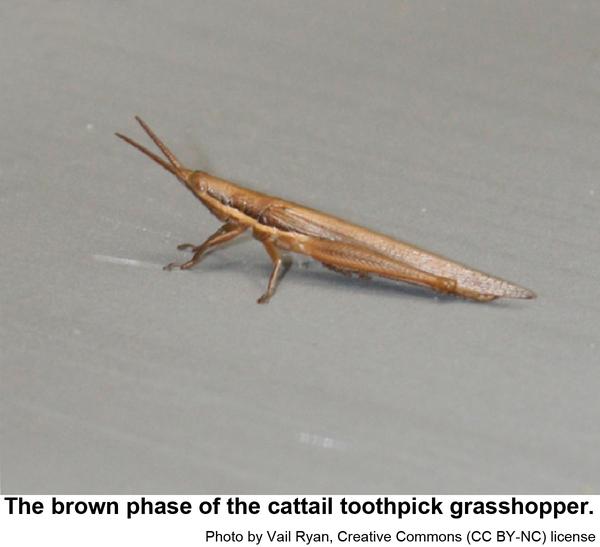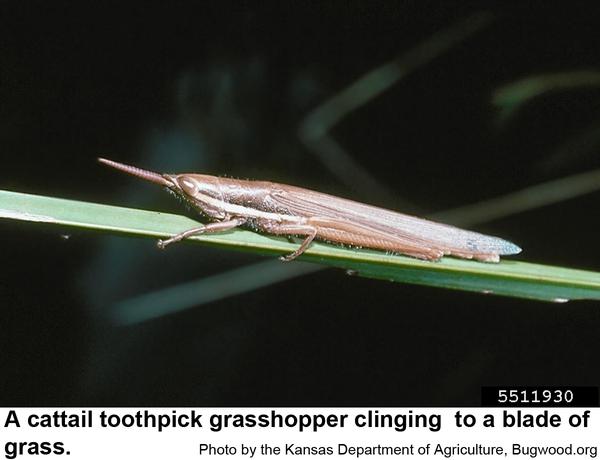Description and Biology
Leptysma marginicollis is unofficially called the cattail toothpick grasshopper because of its habit of feeding on sedges, grasses and rushes bordering ponds and waterways and because it is a slender, elongate insect that is adept at hiding behind slender stems of grasses. The antennae are flattened and held straight ahead, and the face is almost horizontal. Some individuals are mostly green with dark wings, more or less uniformly brown, or green below and brown above, or green below and green/brown above. Many individuals have a pale to white line from each eye across the thorax to the wing. On some, the line is very dark above and pale or white below. On still others, the line may be missing or faint. Adults are slim insects about 2 inches long. The wings protrude noticeably beyond the abdomen. The cattail toothpick grasshopper is often a wary insect and jumps or flies readily or hides behind stems quickly. Adults peak in April and November so we likely have at least two generations per year in North Carolina. If it is like other grasshoppers, females lay their eggs in a mass in soil. From the eggs hatch tiny grasshoppers that feed, molt, and gradually grow into new adults. These nymphs form increasingly larger wing buds as they molt and grow.
Host Plants
Cattail toothpick grasshoppers have been collected feeding on cattails, "bunch" grass, grasses, rushes, sedges, and "water plants."
Residential Recomendations
Because they often feed on plants along waterways and ponds, control of cattail toothpick grasshoppers is somewhat more complicated than control of other leaf-feeding insects on ornamentals. The pyrethroids, bifenthrin and cyfluthrin, are two pyrethroids labeled for grasshopper control in residential landscapes. When used as directed, pyrethroids are very toxic to insects but are not particularly hazardous to humans and pets (other than fish—avoid using pyrethroids around pools, ponds, and streams). Apply pyrethroids in a manner than prevents contamination of lakes and streams. Sevin bait and insecticidal soaps are also labeled for grasshopper control on ornamentals.
Other Resources
- Cattail Toothpick Grasshopper (Leptysma marginicollis). Ueda, K-I. et al. No Date. iNaturalist.
- Invertebrates of Central Texas Wetlands. Taber, S. W. and S. B. Fllenor. 2025 (last observation). Texas Tech University Press. 322 pp.
- The Distribution of Leptysma marginicollis (Serv.). Scudder, S. H. 1900. Psyche 9: 116.
- NC State Extension Plant Pathology Publications
- NC State Horticultural Science Publications
- North Carolina Agricultural Chemicals Manual
For assistance with a specific problem, contact your local Cooperative Extension center.
This factsheet has not been peer reviewed.
Publication date: July 16, 2020
Reviewed/Revised: May 8, 2025
Recommendations for the use of agricultural chemicals are included in this publication as a convenience to the reader. The use of brand names and any mention or listing of commercial products or services in this publication does not imply endorsement by NC State University or N.C. A&T State University nor discrimination against similar products or services not mentioned. Individuals who use agricultural chemicals are responsible for ensuring that the intended use complies with current regulations and conforms to the product label. Be sure to obtain current information about usage regulations and examine a current product label before applying any chemical. For assistance, contact your local N.C. Cooperative Extension county center.
N.C. Cooperative Extension prohibits discrimination and harassment regardless of age, color, disability, family and marital status, gender identity, national origin, political beliefs, race, religion, sex (including pregnancy), sexual orientation and veteran status.



